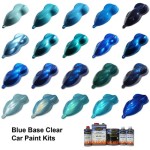How To Paint Landscape Rocks With Acrylics On It
Painting landscape rocks with acrylics can transform ordinary stones into captivating artistic features. This process allows for the creation of unique garden ornaments, personalized gifts, or even indoor decorative accents. Proper preparation, material selection, and application techniques are critical for achieving durable and aesthetically pleasing results. The following provides a comprehensive guide on how to effectively paint landscape rocks using acrylics.
Preparing the Rocks
The initial stage involves preparing the landscape rocks to ensure optimal paint adhesion and longevity. This step is crucial for preventing paint chipping, peeling, and premature fading. The primary goals of rock preparation are to remove loose debris, clean the surface, and, if necessary, prime the rock to create a more receptive base for the acrylic paints.
The first step is to thoroughly clean the rocks. This involves removing any dirt, moss, lichen, or other surface contaminants. A stiff-bristled brush, such as a wire brush or scrub brush, is effective for dislodging stubborn debris. The rocks should be scrubbed vigorously under running water. For particularly dirty rocks, a mild detergent can be added to the water. However, it is essential to rinse the rocks thoroughly afterward to remove any soap residue, as this can interfere with paint adhesion.
Once the rocks are clean, allow them to dry completely. The drying time will vary depending on the size and porosity of the rocks and the ambient weather conditions. Generally, rocks should be left to air dry for at least 24 hours in a dry, well-ventilated area. Alternatively, the rocks can be dried in an oven at a low temperature (around 200°F or 93°C) for a shorter period. However, caution should be exercised to avoid overheating the rocks, which could potentially cause them to crack.
After the rocks are dry, consider applying a primer. A primer serves as a bonding agent between the rock surface and the acrylic paint. It creates a uniform surface that enhances paint adhesion and can also help to seal porous rocks, preventing excessive paint absorption. Choose a primer specifically designed for use on porous surfaces, such as a masonry primer or an acrylic gesso. Apply the primer according to the manufacturer's instructions, using a brush or spray can. Allow the primer to dry completely before proceeding to the painting stage. Multiple thin coats of primer are generally more effective than a single thick coat, as this helps to prevent drips and ensure even coverage.
The selection of rocks is also important. Choose rocks with relatively smooth surfaces to facilitate easier painting. Avoid rocks that are excessively rough, crumbly, or have numerous deep crevices, as these can be challenging to paint and may not provide a stable base for the paint. The size and shape of the rocks will depend on the intended use and aesthetic preferences.
Selecting Acrylic Paints and Tools
The choice of acrylic paints and application tools significantly impacts the final outcome of the rock painting project. Selecting high-quality materials not only ensures vibrant and durable colors but also facilitates a smoother and more enjoyable painting process. Furthermore, appropriate tools are essential for achieving the desired level of detail and precision.
When selecting acrylic paints, opt for artist-grade paints rather than student-grade paints. Artist-grade acrylics contain a higher concentration of pigment, resulting in richer, more vibrant colors and better lightfastness. Lightfastness refers to the paint's resistance to fading over time when exposed to light. Choosing paints with good lightfastness is particularly important for landscape rocks that will be placed outdoors.
Consider the type of acrylic paint. Heavy-body acrylics have a thick, buttery consistency, ideal for creating textured effects and impasto techniques. Fluid acrylics are thinner and more free-flowing, suitable for washes, glazes, and detailed work. Soft-body acrylics offer a balance between the two, providing good coverage and blendability. Select the type of acrylic paint that best suits the desired painting style and techniques.
A variety of brushes are necessary for painting landscape rocks. A selection of round brushes in different sizes is essential for detailed work, such as outlining shapes and adding fine lines. Flat brushes are useful for covering larger areas and creating even strokes. Angled brushes are helpful for painting edges and corners. Consider investing in synthetic brushes, as they are generally more durable and easier to clean than natural-bristle brushes when used with acrylic paints.
In addition to brushes, other useful tools include palette knives for mixing paints and creating textural effects, sponges for applying washes and creating blended backgrounds, and paint palettes for holding and mixing paints. A water container is essential for cleaning brushes, and paper towels or cloths are necessary for wiping up spills and excess paint. For detailed designs, consider using fine-tipped paint pens or permanent markers in addition to acrylic paints.
Safety gear is also important. Wearing gloves can protect the hands from paint stains and irritants. A well-ventilated workspace is essential to avoid inhaling paint fumes. A drop cloth or protective covering should be used to protect the work surface from spills and splatters.
Applying Acrylic Paints and Finishing
The application of acrylic paints to landscape rocks requires careful attention to detail and technique to achieve the desired artistic effect. This stage involves sketching the design, applying base coats, adding details, and protecting the finished artwork with a sealant. The process requires patience and precision to create a durable and visually appealing painted rock.
Before applying paint, it is helpful to sketch the design onto the rock using a pencil. This provides a guide for painting and helps to ensure that the design is accurately represented. Keep the sketch light and erasable, as any visible pencil lines may show through the paint. For complex designs, consider using stencils or transferring the design onto the rock using transfer paper.
Begin by applying a base coat of paint to the entire rock surface. This provides a uniform background for the subsequent layers of paint. Choose a color that complements the overall design or use a neutral color such as white or gray. Apply the base coat in thin, even layers, allowing each layer to dry completely before applying the next. Multiple thin coats are generally more effective than a single thick coat, as this helps to prevent drips and ensure even coverage.
Once the base coat is dry, begin adding the details of the design. Use a variety of brushes and techniques to create different effects. Experiment with blending colors, layering paints, and adding textures. For fine lines and intricate details, use a fine-tipped brush or a paint pen. Allow each layer of paint to dry completely before adding the next to prevent colors from bleeding or mixing unintentionally. Take breaks as needed to prevent eye strain and maintain focus.
After the painting is complete and the paint is thoroughly dry, apply a sealant to protect the artwork. A sealant will protect the paint from moisture, UV rays, and abrasion, extending the life of the painted rock. Choose a sealant specifically designed for use on painted surfaces that will be exposed to the elements. Acrylic sealants are a good option, as they are durable, water-resistant, and UV-resistant. Apply the sealant according to the manufacturer's instructions, using a brush or spray can. Apply several thin coats of sealant, allowing each coat to dry completely before applying the next. Ensure that the sealant covers the entire painted surface, including any edges or corners.
Allow the sealant to cure completely before placing the painted rock outdoors. The curing time will vary depending on the type of sealant used and the ambient weather conditions. Generally, sealed rocks should be allowed to cure for at least 24 to 48 hours in a dry, well-ventilated area. By following these steps, landscape rocks can be transformed into durable and beautiful works of art using acrylic paints.

Acrylic Painting Tutorial On How To Paint Basic Rocks Sunlight Easy For Beginners By Jm Lisondra

How To Paint Rocks And Cliffs Draw Academy

How To Paint Rocks Stones In Acrylic Painting Tutorial

How To Paint Rocks And Cliffs Draw Academy

How To Paint Ocean And Rocks In Oil Or Acrylic

How To Paint Rocks And Cliffs Draw Academy

Realistic Rocks How Do You Paint Them

How To Paint Water Stream Easy Way Rocks Acrylic Painting

How To Paint Rocks And Cliffs Draw Academy

Painting Boulders And Underwater Rocks How To Create A Stunning Lake Scene In Acrylics
Related Posts








